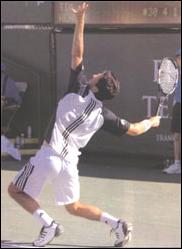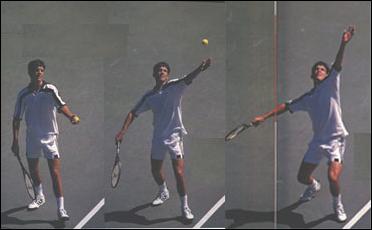Revolutionary Tennis |
||
Tennis Instruction That Makes Sense |
||
Step 12 The Tennis Serve Part 2: Holistic Tennis talks about the "kinetic chain" of body parts "loading" and feeding to/from each other to produce power, or racket acceleration, not only for the serve but also groundstrokes. For the serve it works this way: the legs bend and load and feed the hips; the hips load and feed to the back and torso; the back/torso arches and loads for the shoulders; the shoulders rotate (internally/externally, not like a turnstile) to feed the arm, the arm rotates and the wrist snaps. The concept of a kinetic chain is a linear one, that is part A feeds part B, B feeds C, C to D, and so on until the moment of impact occurs. Part A can not feed part C, so the thinking is if you miss or skip a link in the chain your serve suffers. For the serve you store or load kinetic energy in the larger muscle groups below the waist and then pass this, from one link in the chain to the next, up to the back, shoulders, and to the serve arm that ultimately takes the racket up to the ball. While the idea of a linear kinetic chain is valid and is a cornerstone in bio mechanics if that's all there were to it more players would have great serves and great looking serves, but that is not reality. Something is missing. Arguably linearity is also there for the rest of tennis' strokes, but not for a tennis serve. REVOLUTIONARY: HOLISTIC The manner in which the body develops itself for power (weight shift and loading) for a tennis serve should be viewed not as a chain of events but as a wholeness. Holistic, not linear. In fact both ends of the body (front leg and toss arm) at the same time (@ ball toss) work with the body's center (groin/mid section) to empower the swing (the arm extended behind the body). A holistic interpretation and not merely shoulder flexibility or loading and explosiveness explains why big guys who play football and baseball don't have the big serves and why slim guys like Ivanisevic, Sampras, and Roddick do. Holistic can explain why good servers are flexible in their shoulders, why they look so graceful, why they don't look like they're simply tossing the ball up, loading, and jumping up like a volcano erupting. Holistic explains why someone 180 pounds can serve 150 miles per hour into a box less than 60 feet away.
Definition: Holism: the view that an organic or integrated whole has an independent reality which cannot be understood simply through an understanding of its parts. The body-as-spring or a pole vaulter's pole is a common metaphor when illustrating how the body works for a strong serve. You know, your pro asks you to bend your knees and spring up to smack to the ball, but watching a pro play it is very apparent the side of their body sticks out when the ball is up. Nick Bollettieri has coined the term "hip stretch" in his Sonic Serve video to describe this hip movement. Perhaps hip extension or side thrust would have been better for students because sticking your hip out to the side is not the way you stretch your hips.. It is not a matter of semantics, though, since "hip stretch" still evokes the linear kinetic chain and is not a holistic approach. Tennisone.com coins the phrase "sink and bulge" for bending the knees during the toss and extending the side of the hip outward toward the net. Editor Jim McLennan describes: "As is obvious Roddick sinks and bulges much more than Federer. The bulge or arch can be likened to the energy placed into a bow to shoot an arrow. Andy's greater racquet head speed flows from this as much as any aspect of his serve." Jim is right-on with the application of a bow and arrow but unfortunately he passes the idea without notice because the linear kinetic chain ideas lie in a two dimensional flatland whereas a holistic point of view represents a new third dimension. It wasn't until I prepared this Step that I found a metaphor that represents more what the body is doing in order to launch the stroke. This metaphor embraces the holistic idea and explains more organically why the side of the hip sticks out. And just as important students easily grab onto it and it is seen everywhere, no matter the level. Welcome to the Archer's Bow.
ARCHER'S BOW
This is what we do on a tennis serve, both ends of the body (toss arm and front leg) act together against and with each other to create force to launch the stroke that is between them. Why? To generate a lot of speed in a short time frame to hit a ball within a short distance. If the objective of a tennis serve were to launch the ball as far as possible, like a shot put or a javelin, while I would still use a bowing motion like a javelin thrower begins with I would emphasize an upward rotation and springing of both body and stroke like a shot putter. We, though, have to hit the ball down into a box 60 feet away, hence the application of our form is different. I include photos of pros doing this Archer's Bow. If you look at the side of the waist, or hip, you can see how this area moves out and the toss arm and front leg mimic the effect of a bow's limbs. Rosset's photos are obvious, and McEnroe shows the finished look. It doesn't matter if the knees are in together or spread open, or if the stance is platform or pinpoint, the bowing effect is the big picture around it all. The baseline in Ivanisevic's photos serves as the marker, you can see in the first photo his front hip is even with the baseline and moves beyond it in the second. Roll the mouse over the single photo right to see the movement.
This bowing effect is difficult to see because most serve photos are not taken from the side. I include a montage here of Ivanisevic so you can see what his obvious bow looks like from 2 different angles.
As a result of the Archer's Bow the knees bend and the back arches, which makes bending/arching easier to do. I could easily say something like, "Bending the knees is a myth! Aching the back is a myth!" but that would be silly, superficial, and irresponsible. "Bending" and "arching" alone are difficult and I don't think helpful alone by themselves, but bending and arching are a subset of the Archer's Bow.
You see Sampras, or any really good server, appear loose, relaxed, flexible. Perhaps now it can be seen how relaxation and flexibility lay the foundation to achieving the Archer's Bow instead of setting the table for the linear kinetic chain. Players often instead toss the ball, get the arm up there, bend the knees, arch the back, turn the shoulders, fire the racket, etc., and yet something's missing. You can get lost in the trees and lose sight of the forest. If you think of the one thing, the Archer's Bow, the rest of it can follow more simply and naturally. Give it a try and let me know.
HOW TO ACHIEVE THE ARCHER'S BOW
First stand with your toss arm straight up above your head, and your racket arm down by your side. Then push the side of your waist, or hip, out to the side. Get used to the idea and feeling of bowing out, of keeping your toss arm held up straight and high, your front leg strong. Second, incorporate this with the full stroke. Start with your body's weight on the back foot. As you shift your body weight from your back leg toward the front leg the side of your body bows out, simultaneous with the arms as they go "down together." Hold the position to develop muscle memory, arm up high, weight on front leg, bowing forward at the midesction. Click on the photo below this paragraph 3 times to see 3 photos of me doing the Archer's Bow, and click to stop. This was taken with continuous shooting of the camera, though I am not tossing and hitting the ball. This is a simple explanation for you to follow, move the side of the hip outward and relax downward.
More than moving the side of you hip you are moving your groin area, or body center, to perform the Archer's Bow. Another way to look at it is you are moving your waist line. This weight shift is a small movement that gets lost with the bigger movements that happen later and take all the credit, but like with most things this small event is a set-up for what follows. If I had to pick one thing to practice to enhance your serve, what would it be? There is so much to practice, isn't there, and never enough time to practice even some of it, let alone all of it. How about practicing one thing? How about head-to-toe gracefulness. Gracefulness produces a smooth weight shift and bow, a more consistent and full lift of the toss arm, a more dedicated approach, more confidence prior to contact. I include a gracefulness drill my coach taught me. Practice this one thing for 2 months and get back to me about your results.
A Henman series illustrates what may have been his serve's weakness. He tosses the ball first and then catches up to it with the Bow. Rosset does it the same way, yet he has a bigger serve because he bows more instead of bends more. Tennis magazines write how it is proper to have the body weight on the back foot as you're tossing, but the upcoming section on this will show how myopic that idea is. Tim's priority is the ball toss with the arm. Then he shifts his weight, bows, arches, bends. It is not holistic, or synchronistic, it is clunky. It is linear, done in sections, individually. The serve. It's not about bending your knees. It's not about arching the back. It's not about springing up to the ball. It's about something more, a bigger picture, where even the lowly ball toss is not just about putting the ball up there to hit but is an active part of the power set-up for the serve. The Archer's Bow. Once achieved you will bend, you will arch, you will flex. You will have more. The Archer's Bow works only if you can hold it in place while serving. Once incorporated its power delivery can be amplified by twisting. It's not that important to do this, but if you want to delve deeper.... Next: 3Ts: Toss, Trophy, Twist (& click here please). [photo credits: Joachim Johansson Inside Tennis, March, 2005, GETTY IMAGES. Ivanisevic bow: TENNIS Magazine, September 1996, photo by Stephen Szurlej/TENNIS Magazine. Ivanisevic montage: center, TENNIS Magazine, April, 1993, I'm guessing photo by Stephen Szurlej/TENNIS Magazine; far right; USTA high performance newsletter, Vol. 4, No. 1/2002. McEnroe: from High Tech Tennis, Jack Groppel, 1992, photo by unknown. Rosset: TENNIS Magazine, December 1994, photo by Stephen Szurlej/TENNIS Magazine. Large montage: Federer: TENNIS Magazine, October 2004, photo by Philippe Millereau/DPPI/ICON SMI; Sampras: USTA high performance newsletter, Vol. 7, No. 1/2005; Henin-Hardenne: USTA high performance newsletter, Vol. 7, No. 1/2005; Roddick: Tennis Week, March 22, 2005, photo Ron Angle; Young: Tennis Week, March 22, 2005, photo Ron Angle. Henman bow from behind, Southern California Tennis & Golf, May/June 2005, photo by Tony Chang. Henman series TENNIS Magazine, November 1997, photo by Stephen Szurlej/TENNIS Magazine.] |
|
|
|
||||||||||||||||||||||||||||||||||||||||||||||||||||||||||||||
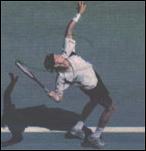 Holistic. Why? Because a bigger kinetic chain has never been the answer. The player with the deepest knee bend, the deepest back arch, the strongest/fastest shoulder extensors or the one with the highest jump does not hit the fastest serve. Many other players bend and arch more than Andy Roddick does, for example Joachim Johansson on the right, yet they don't produce a faster serve.
Holistic. Why? Because a bigger kinetic chain has never been the answer. The player with the deepest knee bend, the deepest back arch, the strongest/fastest shoulder extensors or the one with the highest jump does not hit the fastest serve. Many other players bend and arch more than Andy Roddick does, for example Joachim Johansson on the right, yet they don't produce a faster serve.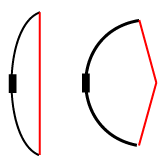 An archer's bow has a top limb and bottom limb to which the bowstring is attached, and between them in the middle is the grip. You hold the grip firmly in place and away from you, pull back on the bowstring, and the two limbs bend back and down. The characteristic bowed position finds the grip out ahead of the arched limbs, and with the bowstring pulled back and the grip held steady out in front the arrow is ready to fly.
An archer's bow has a top limb and bottom limb to which the bowstring is attached, and between them in the middle is the grip. You hold the grip firmly in place and away from you, pull back on the bowstring, and the two limbs bend back and down. The characteristic bowed position finds the grip out ahead of the arched limbs, and with the bowstring pulled back and the grip held steady out in front the arrow is ready to fly.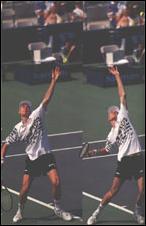
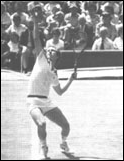

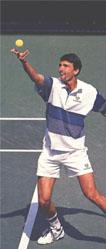
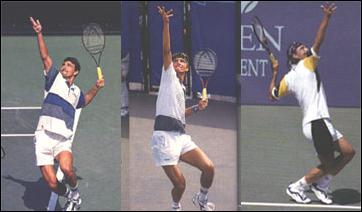 Understanding what the Archer's Bow looks like from Ivanisevic's multiple views will help you see the Bow in the montage that includes Federer, Sampras, Henin-Hardenne, Roddick, and young up and comer Donald Young. Sometimes it's difficult to see the Bow from these different angles, but it's there.
Understanding what the Archer's Bow looks like from Ivanisevic's multiple views will help you see the Bow in the montage that includes Federer, Sampras, Henin-Hardenne, Roddick, and young up and comer Donald Young. Sometimes it's difficult to see the Bow from these different angles, but it's there.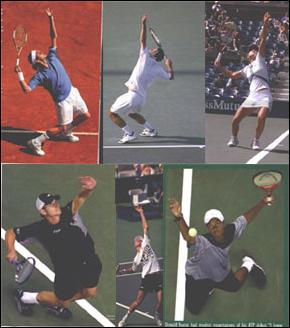
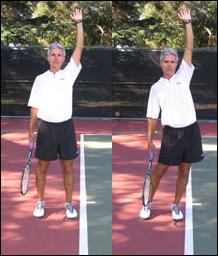
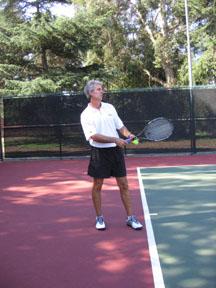 Your anxiety is going to rise from your waist line up into your chest when you shift and bow and lift the arms but it needs to go in the opposite direction, that is down into your stomach and lower body. Allow it to descend as your toss arm rises.
Your anxiety is going to rise from your waist line up into your chest when you shift and bow and lift the arms but it needs to go in the opposite direction, that is down into your stomach and lower body. Allow it to descend as your toss arm rises.